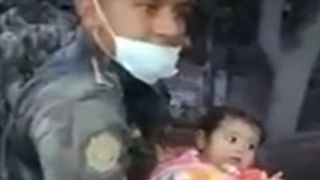Guatemala’s Volcano of Fire has exploded again for the first time since devastating eruptions on Sunday which killed at least 75 people.
National disaster agency Conred ordered evacuations in the town of Escuintla as hot gas and molten rock poured down the southern slopes of the volcano on Tuesday afternoon.
The explosions billowed ash more than 5,000m (16,000ft) above sea level, with Guatemala’s seismology and volcanology institute warning that there is a moderate flow of dangerous material down the volcano – with the possibility of a strong flow in some areas.
Tuesday’s evacuation orders triggered panic and stalled traffic, even in areas which have not been affected by the latest eruption.
About 2,500 people were in shelters in Escuintla after being forced to flee their homes in surrounding villages.
Officials say a total of 192 people remain missing, but the search for bodies in mountainous areas destroyed by the eruption has been progressing slowly.
“We will continue until we find the last victim, though we do not know how many there are. We will probe the area as many times as necessary,” said Sergio Cabanas, the head of Guatemala’s disaster relief agency.
About 10 small eruptions every hour had been reported by seismologists, but none of them compared to the major blast which shook the region on Sunday afternoon.
That eruption unleashed a rapid flow of gas and volcanic debris which quickly enveloped homes nearby, killing those inside.
Warnings had been issued, but they came too late for some communities to escape.
Only 23 of the bodies recovered so far have been identified. Many of the victims are unrecognisable, with officials warning that DNA testing and other methods may be needed to identify them.
Conred spokesman David de Leon said the volcano first erupted around midday on Sunday, billowing smoke and ash miles into the sky. A new, more powerful explosion followed two hours later.
Authorities scrambled to issue an evacuation order. Some communities emptied out safely.
But in places like Los Lotes and the village of El Rodeo, about eight miles downslope from the crater, it was too late for many.
From – SkyNews







